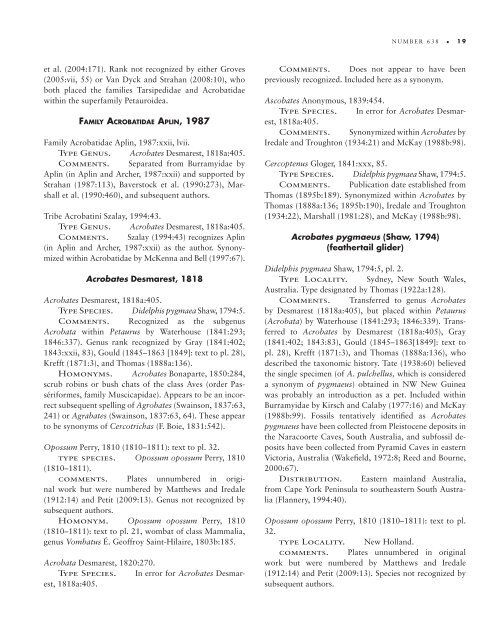Gliding Mammals: Taxonomy of Living and Extinct Species
Gliding Mammals: Taxonomy of Living and Extinct Species
Gliding Mammals: Taxonomy of Living and Extinct Species
You also want an ePaper? Increase the reach of your titles
YUMPU automatically turns print PDFs into web optimized ePapers that Google loves.
et al. (2004:171). Rank not recognized by either Groves<br />
(2005:vii, 55) or Van Dyck <strong>and</strong> Strahan (2008:10), who<br />
both placed the families Tarsipedidae <strong>and</strong> Acrobatidae<br />
within the superfamily Petauroidea.<br />
faMily aCrobatidae aplin, 1987<br />
Family Acrobatidae Aplin, 1987:xxii, lvii.<br />
type genus. Acrobates Desmarest, 1818a:405.<br />
comments. Separated from Burramyidae by<br />
Aplin (in Aplin <strong>and</strong> Archer, 1987:xxii) <strong>and</strong> supported by<br />
Strahan (1987:113), Baverstock et al. (1990:273), Marshall<br />
et al. (1990:460), <strong>and</strong> subsequent authors.<br />
Tribe Acrobatini Szalay, 1994:43.<br />
type genus. Acrobates Desmarest, 1818a:405.<br />
comments. Szalay (1994:43) recognizes Aplin<br />
(in Aplin <strong>and</strong> Archer, 1987:xxii) as the author. Synonymized<br />
within Acrobatidae by McKenna <strong>and</strong> Bell (1997:67).<br />
Acrobates Desmarest, 1818<br />
Acrobates Desmarest, 1818a:405.<br />
type species. Didelphis pygmaea Shaw, 1794:5.<br />
comments. Recognized as the subgenus<br />
Acrobata within Petaurus by Waterhouse (1841:293;<br />
1846:337). Genus rank recognized by Gray (1841:402;<br />
1843:xxii, 83), Gould (1845–1863 [1849]: text to pl. 28),<br />
Krefft (1871:3), <strong>and</strong> Thomas (1888a:136).<br />
homonyms. Acrobates Bonaparte, 1850:284,<br />
scrub robins or bush chats <strong>of</strong> the class Aves (order Passériformes,<br />
family Muscicapidae). Appears to be an incorrect<br />
subsequent spelling <strong>of</strong> Agrobates (Swainson, 1837:63,<br />
241) or Agrabates (Swainson, 1837:63, 64). These appear<br />
to be synonyms <strong>of</strong> Cercotrichas (F. Boie, 1831:542).<br />
Opossum Perry, 1810 (1810–1811): text to pl. 32.<br />
type species. Opossum opossum Perry, 1810<br />
(1810–1811).<br />
comments. Plates unnumbered in original<br />
work but were numbered by Matthews <strong>and</strong> Iredale<br />
(1912:14) <strong>and</strong> Petit (2009:13). Genus not recognized by<br />
subsequent authors.<br />
homonym. Opossum opossum Perry, 1810<br />
(1810–1811): text to pl. 21, wombat <strong>of</strong> class Mammalia,<br />
genus Vombatus É. Ge<strong>of</strong>froy Saint- Hilaire, 1803b:185.<br />
Acrobata Desmarest, 1820:270.<br />
type species. In error for Acrobates Desmarest,<br />
1818a:405.<br />
NUMBER 638 • 19<br />
comments. Does not appear to have been<br />
previously recognized. Included here as a synonym.<br />
Ascobates Anonymous, 1839:454.<br />
type species. In error for Acrobates Desmarest,<br />
1818a:405.<br />
comments. Synonymized within Acrobates by<br />
Iredale <strong>and</strong> Troughton (1934:21) <strong>and</strong> McKay (1988b:98).<br />
Cercoptenus Gloger, 1841:xxx, 85.<br />
type species. Didelphis pygmaea Shaw, 1794:5.<br />
comments. Publication date established from<br />
Thomas (1895b:189). Synonymized within Acrobates by<br />
Thomas (1888a:136; 1895b:190), Iredale <strong>and</strong> Troughton<br />
(1934:22), Marshall (1981:28), <strong>and</strong> McKay (1988b:98).<br />
Acrobates pygmaeus (Shaw, 1794)<br />
(feathertail glider)<br />
Didelphis pygmaea Shaw, 1794:5, pl. 2.<br />
type Locality. Sydney, New South Wales,<br />
Australia. Type designated by Thomas (1922a:128).<br />
comments. Transferred to genus Acrobates<br />
by Desmarest (1818a:405), but placed within Petaurus<br />
(Acrobata) by Waterhouse (1841:293; 1846:339). Transferred<br />
to Acrobates by Desmarest (1818a:405), Gray<br />
(1841:402; 1843:83), Gould (1845–1863[1849]: text to<br />
pl. 28), Krefft (1871:3), <strong>and</strong> Thomas (1888a:136), who<br />
described the taxonomic history. Tate (1938:60) believed<br />
the single specimen (<strong>of</strong> A. pulchellus, which is considered<br />
a synonym <strong>of</strong> pygmaeus) obtained in NW New Guinea<br />
was probably an introduction as a pet. Included within<br />
Burramyidae by Kirsch <strong>and</strong> Calaby (1977:16) <strong>and</strong> McKay<br />
(1988b:99). Fossils tentatively identified as Acrobates<br />
pygmaeus have been collected from Pleistocene deposits in<br />
the Naracoorte Caves, South Australia, <strong>and</strong> subfossil deposits<br />
have been collected from Pyramid Caves in eastern<br />
Victoria, Australia (Wakefield, 1972:8; Reed <strong>and</strong> Bourne,<br />
2000:67).<br />
distribution. Eastern mainl<strong>and</strong> Australia,<br />
from Cape York Peninsula to southeastern South Australia<br />
(Flannery, 1994:40).<br />
Opossum opossum Perry, 1810 (1810–1811): text to pl.<br />
32.<br />
type Locality. New Holl<strong>and</strong>.<br />
comments. Plates unnumbered in original<br />
work but were numbered by Matthews <strong>and</strong> Iredale<br />
(1912:14) <strong>and</strong> Petit (2009:13). <strong>Species</strong> not recognized by<br />
subsequent authors.

















